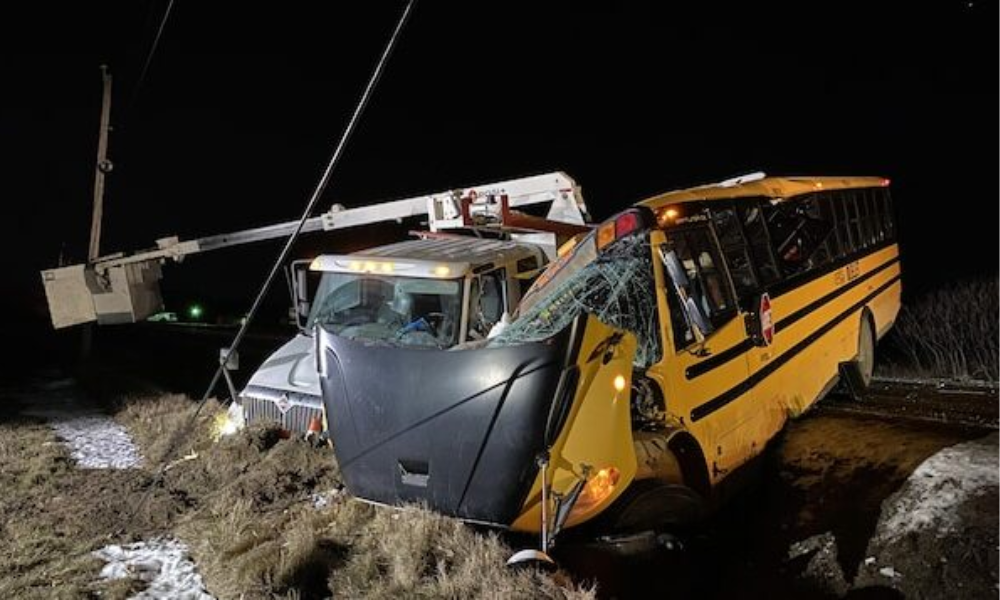5-year-old boy died when school bus hit bucket truck

Better signage and traffic practices could have prevented a collision between a school bus and a bucket truck that killed a 5-year-old boy and seriously injured a 10-year-old boy as well as the 70-year-old bus driver, according to Quebec’s workplace health and safety board.
Quebec’s Commission for Standards, Equity, Health, and Safety at Work (CNESST) released an extensive report into the incident that occurred in December 2021 in Lyster, Quebec. It found the bucket truck “partially obstructed” the traffic lane and the safety precautions were “deficient” due to “inadequate signage.”
The school bus crashed into the bucket truck while two workers were installing fiber optics cables. They were working for Les Entreprises Quebecoises D’excavation (LEQEL de Quebec).
The bucket truck blocked nearly half of the lane explained Stéphanie Rosa, occupational health and safety inspector at the CNESST, during a press conference covered by leSoleil.
Lack of signage
“The shoulder was used to its maximum of one meter. There was still 1.44 meters sticking out in the traffic lane. The truck was blocking 40% of the lane. It was impossible for two vehicles to pass in the open lane,” said Rosa.
The investigation also revealed only one road sign was used to notify drivers of the obstruction and it was placed just 38 metres from the bucket truck. Quebec regulations state a first sign notifying other drivers of the work should have been placed 354 metres from the work site, followed by several more.
“Indeed, the road signs were inadequate for the work that was being done,” said Rosa, who also found a signal light should have been used, “a warning light to stop and allow alternating traffic to bypass the work area.”
How the accident happened
An animation produced by CNESST shows exactly how the accident unfolded and demonstrates why better signage could have prevented it from happening.
The investigation also discovered a lack of training and supervision of workers regarding the use of road signs. The employer, LEQEL, did not provide a signage plan, or include road signs as part of its prevention program.
At the time of the accident the bucket truck was being driven slowly by one worker, stopping frequently while the other worker attended to the fiber optic lines. Rosa said even though the vehicle was in motion, it was still possible to have adequate signage. “We can plan a work area that is much larger to make sure to allow the truck to move within the protected area. It is up to the employer to determine the right work area to carry out the task.”
The position of the sun at the time of the accident was also a factor, according to the report. The sun was at eye level for the bus driver, creating a glare.
Other drivers who passed by the bucket truck minutes before the accident indicated they didn’t realize work was in progress until they saw the truck.
“It is possible to see that with the present conditions, the immobilized bucket truck became visible at the last moment. It was then difficult to anticipate the presence of the obstruction by the vehicle in the traffic lane”, reads the report.
The reduced visibility caused by the position of the sun made adequate road signage that much more important according to Rosa. “They would have seen the signs… they would still have had time to anticipate the zone, despite the declining sun.”
Employer fined
LEQEL was fined, but the amount has not been disclosed. The amount of a first offence varies between $17,000 and $35,000. But a repeat offence can lead to fines as high as $352,000, and this was not the first incident for LEQEL.
A worker was seriously injured in July 2021 while working on a traffic lane. The CNESST ordered the company to train its workers on road signs. The company says it was still in the process of setting up that training program when the bus crashed into the bucket truck in December of that year.
The company has yet to provide CNESST with evidence of its road sign training program and has not been allowed to resume operations.
CNESST will send the findings to various organizations in the province including training institutions.
“The objective of carrying out this type of investigation is to do prevention,” explained Rosa, who hopes the report will help employers, workers, and drivers better recognize the importance of road safety signs.





